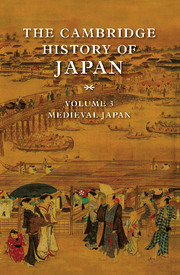Book contents
- Frontmatter
- Introduction
- 1 The Kamakura bakufu
- 2 Medieval shōen
- 3 The decline of the Kamakura bakufu
- 4 The Muromachi bakufu
- 5 Muromachi local government: shugo and kokujin
- 6 The decline of the shōen system
- 7 The medieval peasant
- 8 The growth of commerce in medieval Japan
- 9 Japan and East Asia
- 10 CULTURAL LIFE IN MEDIEVAL JAPAN
- 11 The other side of culture in medieval Japan
- 12 Buddhism in the Kamakura period
- 13 Zen and the gozan
- Works cited
- Glossary
- Index
- References
6 - The decline of the shōen system
Published online by Cambridge University Press: 28 March 2008
- Frontmatter
- Introduction
- 1 The Kamakura bakufu
- 2 Medieval shōen
- 3 The decline of the Kamakura bakufu
- 4 The Muromachi bakufu
- 5 Muromachi local government: shugo and kokujin
- 6 The decline of the shōen system
- 7 The medieval peasant
- 8 The growth of commerce in medieval Japan
- 9 Japan and East Asia
- 10 CULTURAL LIFE IN MEDIEVAL JAPAN
- 11 The other side of culture in medieval Japan
- 12 Buddhism in the Kamakura period
- 13 Zen and the gozan
- Works cited
- Glossary
- Index
- References
Summary
The shōen system of landholding, one of the most important institutions for organizing the economic life of medieval Japan, was transformed at the end of the eleventh and the beginning of the twelfth centuries. The transformation occurred when Minamoto Yoritomo, who established the Kamakura bakufu, created the offices of shugo (military governor) and jitō (military estate steward), introducing a new layer of tenurial rights into the shōen hierarchy in 1185. Following the Jōkyū disturbance of 1221, the shogunate confiscated the lands of the nobles and warriors who had taken part in the incident and appointed its loyal retainers (gokenin) as jitō to these lands. Both of these events served to establish firmly a lord–vassal relationship within the proprietary rights structure of the shōen system and marked the beginning of a long process that saw the emerging dominance of warrior authority and the declining power of the central proprietor over the land, its revenues, and inhabitants.
The appointment of jitō by the Kamakura bakufu was intended to supplement rather than supplant the land rights and political authority of the shōen proprietors who traditionally possessed full fiscal and administrative power over these “private lands.” This policy did not completely deny the shōen as a form of land proprietorship, nor did it mean that the jitō acquired exclusive proprietary rights on the shōen to which they were appointed. In fact, the Kamakura bakufu struggled to preserve the shōen system and to prevent the jitō from extending their authority beyond the scope intended by the bakufu.
- Type
- Chapter
- Information
- The Cambridge History of Japan , pp. 260 - 300Publisher: Cambridge University PressPrint publication year: 1990



